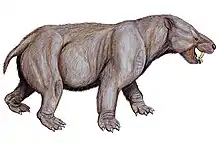Titanoides
Titanoides is an extinct genus of pantodont mammal that lived in North Dakota. They were up to 3 m (9.8 ft) long and up to 150 kg (330 lb) in weight, being the largest mammals of their habitat, a tropical swampland where the main predators were crocodiles. They had a bear-like appearance with huge canines, short limbs and five clawed digits; however, they were herbivores and probably had traits and attributes more similar to diprotodontids.[2][3]
| Titanoides | |
|---|---|
 | |
| Scientific classification | |
| Kingdom: | |
| Phylum: | |
| Class: | |
| Order: | |
| Suborder: | |
| Family: | †Titanoideidae |
| Genus: | †Titanoides Gidley, 1917 |
| Type species | |
| †Titanoides primaevus Gidley, 1917 | |
| Species[1] | |
| |
References
- "Pantodonta". After McKenna & Bell (1997) and Alroy (2002). Retrieved 2 November 2013.
- "Titanoides" (PDF).
- "Pantodonts, uintatheres and xenungulates: The first large herbivorous mammals". Paleocene mammals of the world.
This article is issued from Wikipedia. The text is licensed under Creative Commons - Attribution - Sharealike. Additional terms may apply for the media files.




